
12 minute read
Go on a road trip
Go on aroad trip…
Explore the outstanding Norfolk coast by going on a road trip! Here are two itineraries to try. The East trip goes up the east coast from Gorleston to Cromer. The North trip takes you from King’s Lynn to Cromer. Read on...







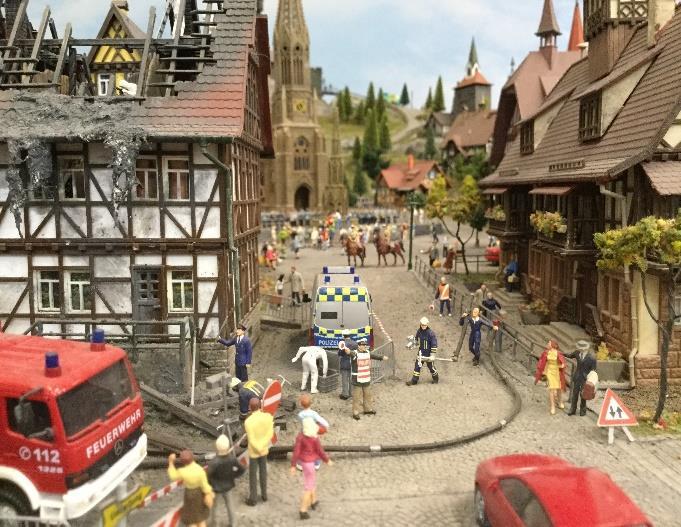

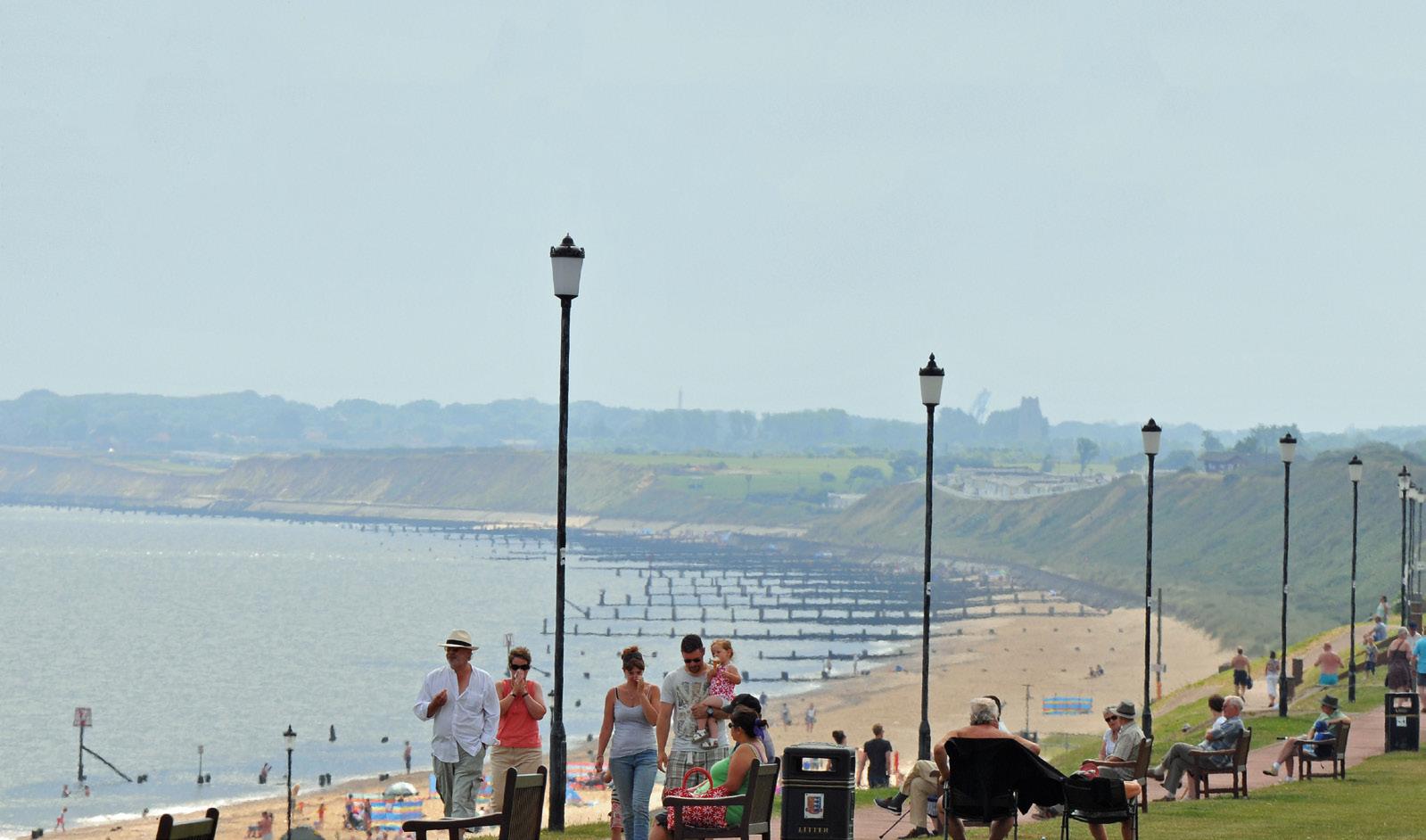
East Road trip…
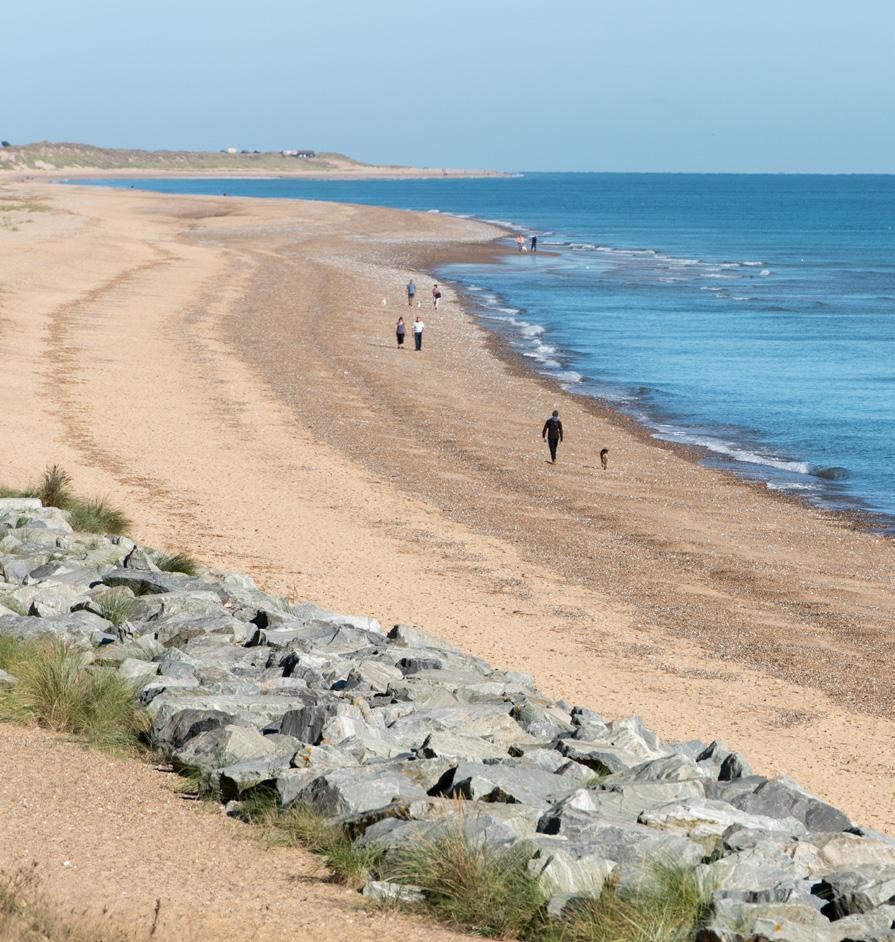
Gorleston cliffs California
From the Norfolk-Suffolk border at Hopton-on-Sea, with the exception of the harbour’s mouth between Gorleston-on-Sea and Great Yarmouth, there is an unbroken stretch of fabulous sandy beach all the way up to north Norfolk. The B1159 will take you to Cromer.
Gorleston is Great Yarmouth’s quieter sister, but it has a magnificent beach backed by a low cliff with esplanade walks, popular with dog walkers. The Pier Hotel was featured in Danny Boyle and Richard Curtis’ Yesterday movie. Just across the river Yare is Great Yarmouth, one of the top holiday destinations in the UK and a mecca for families and fun-lovers who want to enjoy a traditional seaside break. The action here focuses on the Golden Mile, with its two piers, amusement arcades, rides and attractions. At the northern end of the Golden Mile, by the racecourse, the beach is tufted with marram grass and dunes and is perfect for dog walking. Look out for the revamped Venetian Waterways and the Hippodrome Circus, the last purpose-built circus building in the country which retains its water spectacular.
Winterton beach At Caister-on-Sea you’ll see one of the two independent lifeboat stations in the UK (the other is a little further up the coast at Hemsby), famous for its crews’ bravery. Close by is California, named after the California, USA gold rush because some 16th century gold coins were found on the beach here in 1848. After Hemsby, with its seaside cafes and amusements, we come to Winterton-on-Sea, which has a wonderful beach which offers popular walks across the dunes (where you might find terns, natterjack toads and the odd adder). Sights here include the pastel-painted, thatched Hermanus roundhouses. The spot is fast becoming popular with windsurfers… and seals!
Horsey is unique in that it’s a coastal village which is on the Broads. The National Trust-owned Horsey windpump has a top deck from which you can gaze out across Horsey Mere. There are riverboat trips and the Mere itself can be easily walked around. Arthur Ransome featured Horsey in a number of his stories, and John Betjeman documented a magical swim in the Mere in his poem East Anglian Bathe. Head down to the beach and you might see the local colony of seals bobbing about in the water, people-watching. There are more good beaches at Waxham, Sea Palling, Eccleson-Sea and Cart Gap, all of which are protected by flood defence works. Sea Palling has some shallow horse-shoe bays. Sadly, nothing can be done about coastal erosion at Happisburgh, which is slowly slipping into the sea. The picturesque red and white striped lighthouse stands defiantly on the cliff. This is also the focal point of the Deep History Coast, where the earliest human footprints outside the Great Rift Valley in Africa were found… meaning the first tourists to this country came to visit Norfolk! Finally, before reaching Overstrand and Cromer, you’ll come to Mundesley, a cheery spot with a good sandy beach and line of colourful beach huts.
Happisburgh lighthouse

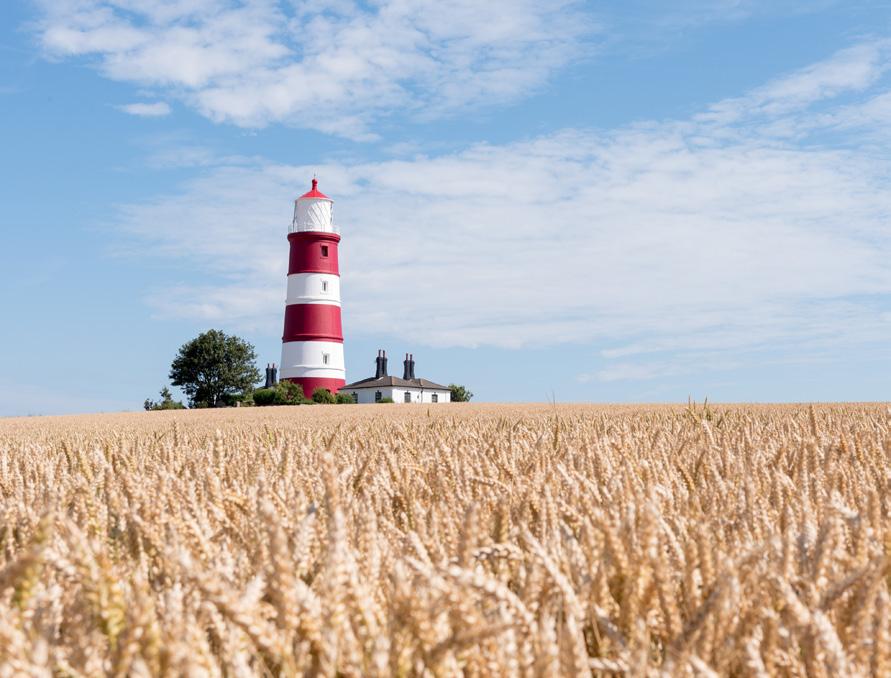
North Road trip…


Holme Dunes
Let’s take a trip along the north Norfolk A149 coastal road between King’s Lynn and Cromer that takes in the gently undulating landscape, pretty coastal villages, flint cottages and lots of welcoming pubs and restaurants… or to get closer still, follow the Norfolk Coast Path. This is all part of the Norfolk Coast Area of Outstanding Natural Beauty.
The coastline here varies enormously, with long stretches of golden beach interspersed with mud flats and salt marsh, shingle and pebbles and soaring cliffs. In some places low tide means the sea almost disappears into the distance, leaving children to pick amongst seashells and observe lugworms casting their coils. There are wonderful dunes and marram grass to traverse, and between King’s Lynn and Hunstanton treacle-like mud where The Wash empties into the North Sea – a favourite of birds and birdwatchers alike. Be at RSPB Snettisham for daybreak and you’ll see the amazing sight of thousands of waders taking flight. Affectionately known as Sunny Hunny, Hunstanton is the only coastal town in the East of England that faces west. The beach is a gentle slope of sand backed by red-and-white-striped cliffs. There’s all the fun of a traditional family bucket-and-spade holiday to be had here, with amusements, candyfloss, doughnuts, donkey rides – and a bandstand.
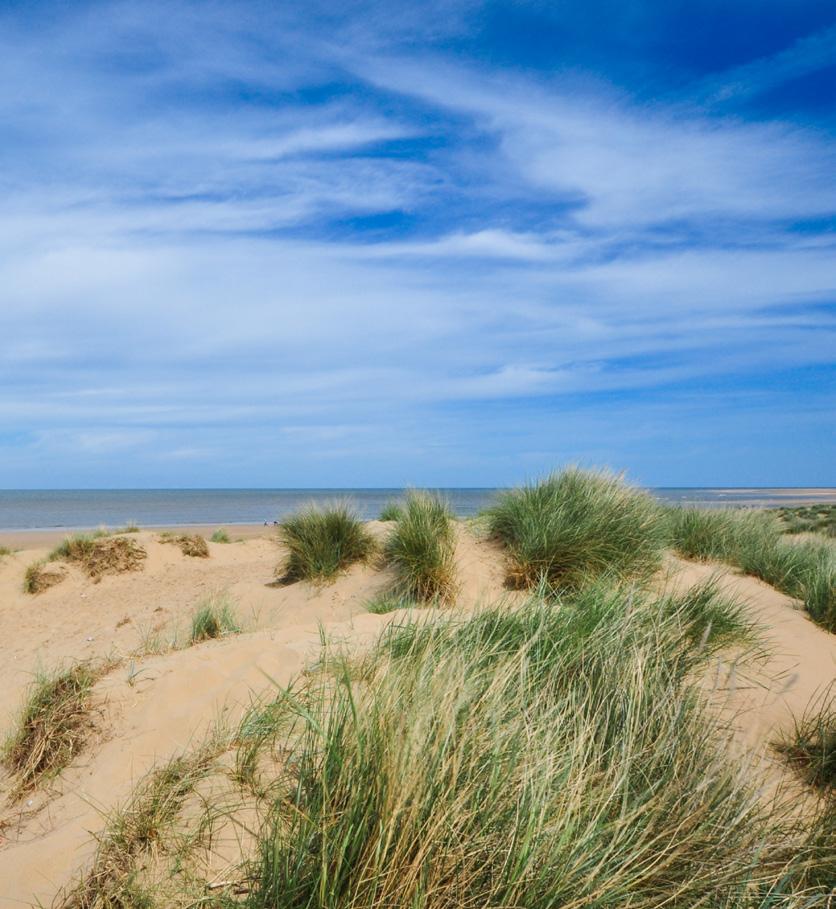

Heacham’s village sign commemorates Pocahontas, who helped create The Special Relationship with north America by marrying local man John Rolfe. Look out here for Norfolk Lavender, brought to Norfolk by the Romans.
Burnham Overy Staithe
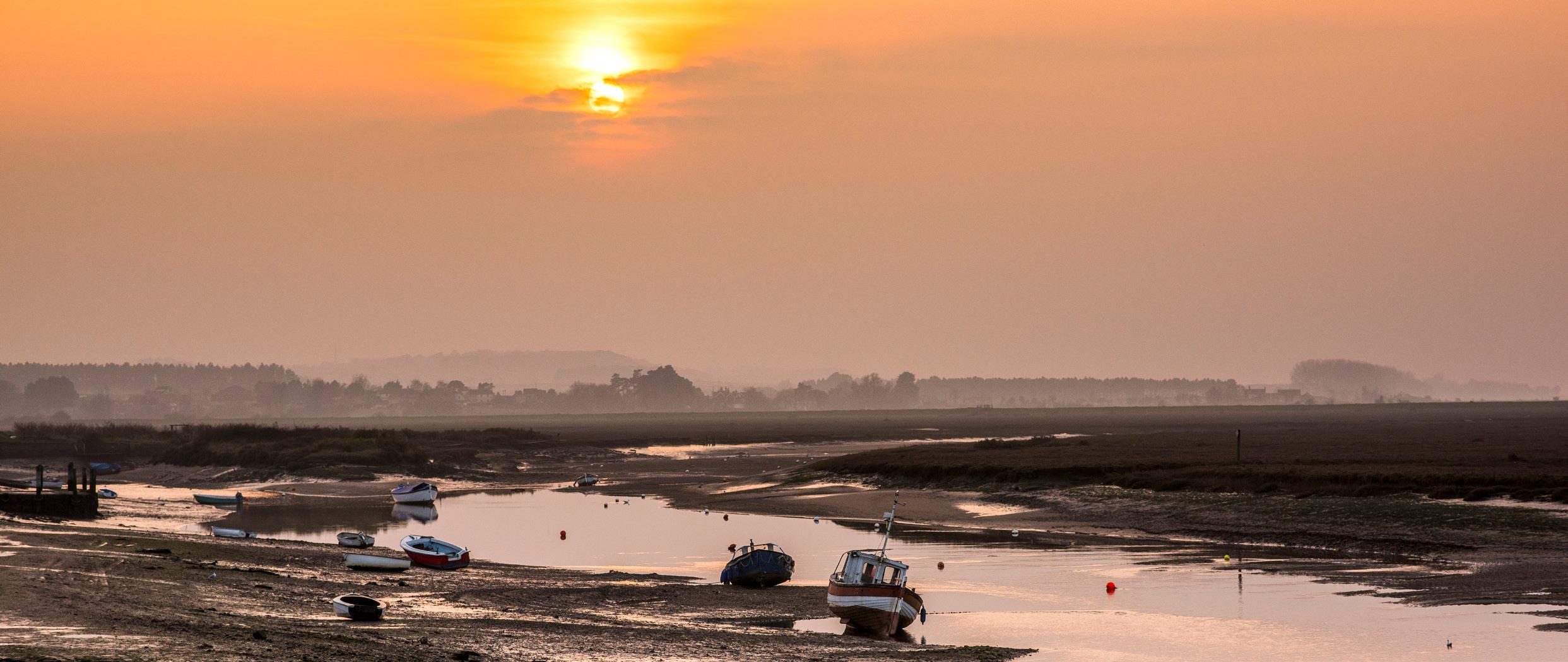
Holkham Beach
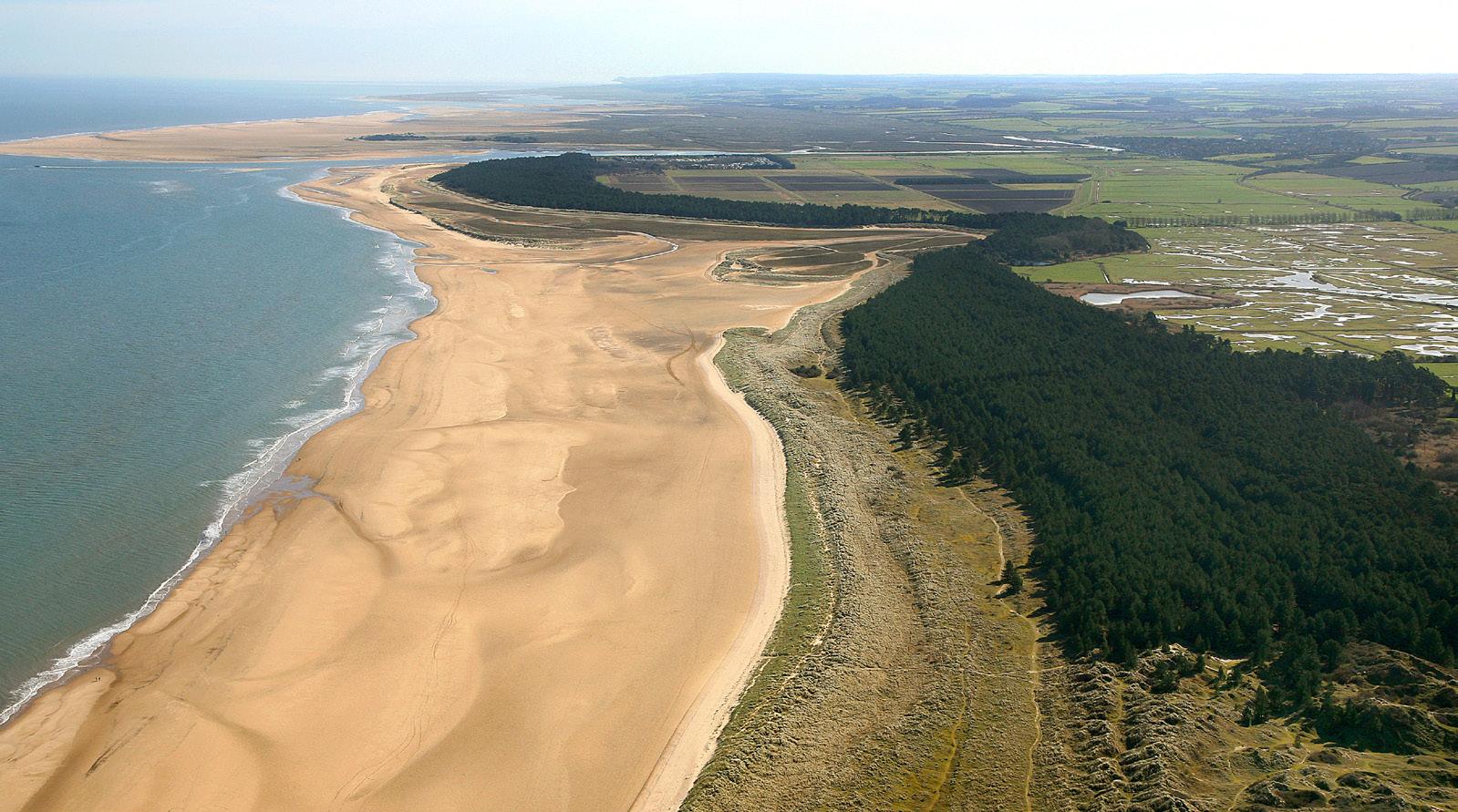
At sunset all activity stops to watch the sun sink slowly behind Lincolnshire. Try fooling someone that it’s actually Holland… there’s always one who falls for it! Take a Searles Sea Tour in the Wash Monster to see The Wash seals.
After Hunstanton the coast takes a dramatic turn, from expansive beach and colourful cliffs to tidal estuaries of salt marsh as well as sand. At Holme-next-the-Sea the Norfolk Wildlife Trust-run Holme Dunes National Nature Reserve has salt and freshwater marshes, pine woodland and reedbeds which attract waders and migrant wildfowl, as well as nesting birds such as oystercatchers and ringed plover in spring and summer. It was here in 1998 that gales uncovered a prehistoric circle of timber posts. A recreation of ‘Seahenge’, as it inevitably became known, can now be seen in the King’s Lynn Museum. Once a smuggler’s haven in the 18th and 19th centuries the village of Thornham is now a tranquil coastal community, beyond which there’s more twitching activity at the RSPB’s Titchwell Marsh Nature Reserve where from the hides you might see avocets, marsh harriers and bearded tits.
Brancaster village is focused around the harbour, which is great for fishing and sailing. Brancaster is famous for its seafood, particularly mussels, and there are plenty of places to enjoy some of the delicious local food. The beach at Brancaster is perfect for kite flying, watersports or just soaking up the refreshing sea air. Amongst the sandhills is the Royal West Norfolk Golf Club, a great links course. At Brancaster harbour you will find the National Trust’s Millennium Activity Centre, from where you can take guided walks, birdwatching rambles and sailing courses. Oh, and a seafood sarnie from the Crab Hut.
The saltmarshes begin again at Burnham Deepdale and Burnham Overy Staithe, protected from the sea by Scolt Head Island National Nature Reserve, in the care of Natural England. A mixture of dune, shingle, marsh and mudflats, the environment is perfect for birdlife, from migrating wildfowl and breeding terns to waders such as the wigeon, teal, shelduck and curlew.
This is where Horatio Nelson, born at nearby Burnham Thorpe, learnt to sail.
Remember the end of Shakespeare in Love, with Gwyneth Paltrow’s Viola shipwrecked on a mesmerically vast beach that’s meant to be the New World? It was filmed at Holkham Bay, our next stop. Stroll through or play hide and seek in the dense pine woodlands, breathing in the aromatic smell of the forest before stepping onto a wide open expanse of beach, one of the most dramatic beaches in the UK and very popular with visitors in the summer season when you feel you could almost be in the Caribbean!
Access to the beach is via Lady Anne’s Drive at Holkham village, or along the coast road west at Wellsnext-the-Sea. There is ample paidfor parking at both. Visit the Palladian splendour that is Holkham Hall.
The town of Wells-next-the-Sea has a timeless quality, like stepping into another world where you will soon feel completely relaxed and at ease. There is space for everyone on the sweeping beach, a truly picture postcard setting with its candycoloured line of huts. Enjoy a wander along the sand, through the dunes or pine forest, find a spot for a quiet picnic or a game of beach cricket. At low tide you’ll wonder where the sea has gone. Stare off to the horizon at low tide and you’ll just be able see the rolling white surf. Just a short distance from the beach you will find the attractive harbour and town, with its distinctive individual shops and fine restaurants. Crabbing on the quay is popular. The town is also home to the Wells and Walsingham Light Railway, the longest 10¼” narrow gauge steam railway in the world. A great experience for the whole family the train winds through the picturesque countryside to the quaint village of Walsingham, which has been a place of pilgrimage for many centuries. From Stiffkey and at Morston through to Blakeney and Cley-nextthe-Sea is a wonderfully natural and dynamic area of pristine tidal saltmarsh, vegetated shingle, dunes and grazing marsh. From Morston quay you can take exhilarating boat trips to see the seal colony at Blakeney Point, a 3-mile long sand and shingle spit which is an important breeding ground for terns as well as being home to Common and Grey seals. Don’t miss the picturesque village and harbour of Blakeney. Boat trips to the seals go from here too. A bustling coastal village crammed full of picturesque flint-lined cottages, Cley’s highlights include Cley Windmill and St. Margaret’s Church, delicatessens, fine pubs and restaurants. From Cley Marshes Nature Reserve you can walk along Blakeney Point. After Salthouse and Weybourne (visit the Muckleburgh Collection military museum), sandy beaches begin again, leading to seaside Sheringham, another links gold course, and Sheringham Park, a National Trust property with coastal views through the mass of rhododendrons. At Sheringham you can take the North Norfolk Railway, known as ‘The Poppy Line’, which stretches 5 miles to the pretty Georgian town of Holt with stops at Weybourne Heath and Kelling Halt. The undulating cliffs are at their highest at Beeston Bump (203 feet) at Beeston Regis. A geological feature called a kame, the Bump looks like a giant molehill – and is ideal for kite-flying. On the beach below can be found stunning flint formations, called paramoudras – known here as pot stones. Black Shuck, a ferocious ghostly black dog from hell, the size of a small horse, with malevolent, flaming red eyes, is said to appear from the depths of Beeston Bump. Sir Arthur Conan Doyle, who had been on a golfing holiday at the Links Hotel in nearby West Runton, heard about the legend and used it as influence for the Sherlock Holmes story, The Hound of the Baskervilles.
Directly behind Sheringham is the Cromer Ridge, the result of a terminal moraine at the end of the last Ice Age. Stand at Roman Camp and you’ll be at the highest point in the East of England. Finally on this northern stretch of the coast, we come to Cromer, dramatically poised on a high bluff. A charming seaside resort which came to popularity with the arrival of the railway, the town has a Victorian pier with a theatre at its end. At this point the coast begins to curve southwards, towards Great Yarmouth.
Beeston Bump and Sheringham

Redwings Horse Sanctuary
A fun family day out

Dog Art CoursesArt CoursesArt Courses
friendly!Drawing | Painting | Craft | PrintDrawing | Painting | Craft | PrintDrawing | Painting | Craft | Print
A creative art school based in a grade II listed A creative art school based in a grade II listed A creative art school based in a grade II listed building in the heart of the Norfolk building in the heart of the Norfolk building in the heart of the Norfolk countryside. We offer a range of structured countryside. We offer a range of structured countryside. We offer a range of structured courses for all levels, taught by well renowned courses for all levels, taught by well renowned courses for all levels, taught by well renowned artists from across the UK.artists from across the UK.artists from across the UK.
We have two centres in Norfolk! Tutors include: Sue Welfare | Mo Teeuw | Marie Antoniou Hashim Akib | Jo Hammond | Lee Deary Tutors include: Sue Welfare | Mo Teeuw | Marie Antoniou Hashim Akib | Jo Hammond | Lee Deary Tutors include: Sue Welfare | Mo Teeuw | Marie Antoniou Hashim Akib | Jo Hammond | Lee Deary Andrea Taylor | Chris Blackburn | Elizabeth Carter Andrea Taylor | Chris Blackburn | Elizabeth CarterAndrea Taylor | Chris Blackburn | Elizabeth Carter
Pippa Pease | Maxine Byron | Hans RahnPippa Pease | Maxine Byron | Hans RahnPippa Pease | Maxine Byron | Hans Rahn
Meet friendly rescued horses and donkeys at
Redwings Aylsham, nr Norwich, NR11 6UE or Redwings Caldecott, nr Gt.Yarmouth, NR31 9EY Church Hill School | 71 Gayton Road |Grimston |Norfolk | PE32 1BG Church Hill School | 71 Gayton Road |Grimston |Norfolk | PE32 1BGChurch Hill School | 71 Gayton Road |Grimston |Norfolk | PE32 1BG Open 10am to 4pm every Friday, Saturday, Sunday and Monday To pre-book your tickets please visit our website www.redwings.org.uk/visiting | 01508 505246 P: 01485 240 420 | E: art@norfolkcreativearts.co.uk www.norfolkcreativearts.co.uk P: 01485 240 420 | E: art@norfolkcreativearts.co.uk www.norfolkcreativearts.co.uk P: 01485 240 420 | E: art@norfolkcreativearts.co.uk www.norfolkcreativearts.co.uk
1 MAY - 25 SEPT, 2022

HOUGHTON HALL STABLES NORFOLK PE31 6TY
SEE HOUGHTONHALL.COM FOR OPENING TIMES AND TICKET PRICES
Celebrating the horticultural and the cultivated landscape behind and beyond the garden wall.






